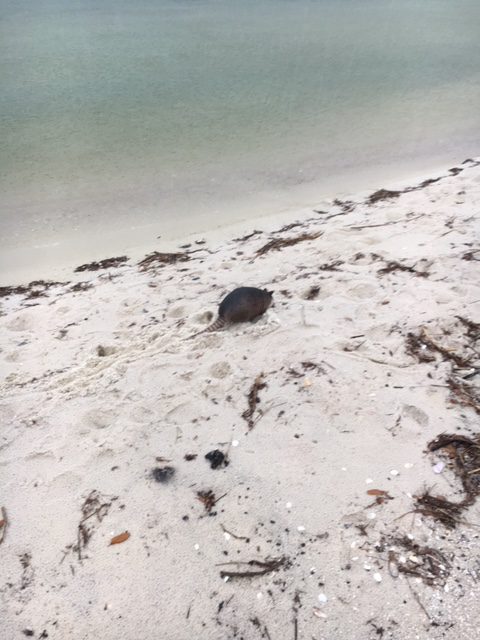
by Rick O'Connor | Aug 21, 2020
You are probably not going to see them… but they are there.
Mammals are fur covered warm blooded creatures. Beaches are hot, dry, sandy places. Just as in the deserts, it would make sense for island mammals to be nocturnal. We know of their existence by their tracks and their scat. Rabbit, raccoon, and armadillo tracks are quite common. Deer, coyote, and beach mice less so. All that said, some are seen at dawn and dusk and it is not unheard of to see them in the middle of the day – especially during the cooler months.
One question that may come up is – “how did they get to an isolated island?” Some scientists have a lot of fun trying to solve that mystery. Some island mammals, like otters, are very good swimmers and would have no problem. Many barrier islands begin as sand spits connected to the mainland – the mammals ventured out into new territory – set up camp – and either over time, or over night in a hurricane – the spit breaks off and the mammals are there. And let’s not forget we built bridges – they know how to use them. Coyotes have been seen walking across the Bob Sikes Bridge from Gulf Breeze.
Another question that comes up – “where are they in the middle of the day?” Most dig, or find, burrows and dens. Just a few inches below the surface it is very cool. Some will find thick hammocks in the maritime forest and “hunker down” for the day.
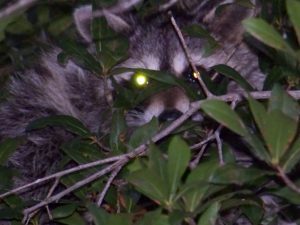
The sneaky raccoon is an intelligent creature and has learned to live with humans.
Photo: Molly O’Connor
Raccoons
The raccoon (Procyon lotor) is one of the more intelligent and fearless of the beach mammals. Their opportunistic behavior frequently brings them into contact with humans. They will scurry across your lawn at night looking for insects, cat food, garbage, whatever they can find to eat – and outdoor lights do not seem to bother them. There are even videos of them reaching into “dog doors” searching. On the island, their tracks are often found in the marsh areas – where they grab shellfish and are one of the few animals that wash their food before eating it. They usually like to settle into hollow trees during the day. But on the island, it is more likely burrows in the sand.
Their tracks might show the presence of a claw (always hard in soft sand – better chance in wet). The front foot is smaller than the back and they walk with an alternating pattern – usually the front and back foot are close to each other – unless they are running. The front foot is about 2.5”x2.5” – a little round, and the index from the pad to the tip is thinner. The hind foot is about 2.5” wide but closer to 4” long.
The scat is cigar shaped and about 3” long.
Read more:
https://myfwc.com/media/1666/livingwithraccoons.pdf.
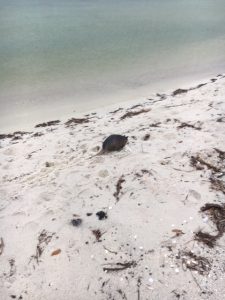
The bizarre looking armadillo enjoys a walk on the beach.
Photo: Rick O’Connor
Armadillo
Here is an interesting creature. It doesn’t even look like a mammal – not sure what it looks like. But mammals they are. If you find one that has been hit by a car you can see, amongst the armored plating, hairs spaced across the body – they are mammals. It is one that is sometimes seen roaming in the middle of the day. They plunge through the leaf litter and bushes of the maritime forest, making a lot of noise, while searching for insects and grubs and crushing them with their peg-like teeth. They are not from around here – rather from central America – and worked their way into the American southwest and southeast. They probably reached the island via the bridges. They are prolific produces – usually having quadruplets of the same sex. You once found them occasionally in the national seashore – but since Hurricane Ivan, you can find them almost anywhere. One bothersome fact of this animal – they are known to carry leprosy – which can be contacted by eating the animal, or handling it.
Their tracks are one of the most common on the beach. The front foot is about 1.8” long and 1.4” wide. You will see only four toes and claw marks may be seen. The two middle toes are longer. The hind foot has a similar pattern, but you will see five toes and they are about 2.2” long. Most tracks include the tail drag between the foot marks. These are quite common all over the island.
The scat is round-ish and not very long – about 2”.
Read more:
https://edis.ifas.ufl.edu/pdffiles/UW/UW45600.pdf
https://myfwc.com/wildlifehabitats/profiles/mammals/land/armadillo/
https://www.floridamuseum.ufl.edu/science/five-facts-nine-banded-armadillo/.
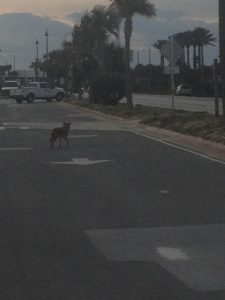
A coyote moving on Pensacola Beach near dawn.
Photo provided by Shelley Johnson.
Coyote
This is an animal that makes people nervous. They are one of the larger mammals on the beach, and they are carnivores. Attacks on pets and children are a concern for many. However, this is rarely the case. Studies show that they are actually very nervous around people and tend to stay at a distance. However, if fed cat food or available garbage, they will lose that fear and problems can occur. Like most island mammals, they are nocturnal, and diet studies have found the bulk of their meals are rodents – which is doing us a favor. But, like raccoons, they are intelligent and opportunistic. If they find an easy meal, like shorebird and turtle eggs – or the chicks and hatchlings – they will take them. It was once thought they were creatures of the American west and migrated into the eastern United States. Some scientists have found coyote remains in the eastern US that predate the ice age – so maybe they are just returning home. There are also reports of humans bringing them here for “fox hunts” – not realizing these were not fox. Either way, they are in all 67 counties of Florida, and on Pensacola Beach. They look similar to dogs – but will be thinner and their tails hang down between their legs when they run. One way to know if they are around is to listen when a siren is going – they tend to howl at these.
Their tracks are very similar to dogs and more people are bringing dogs onto the beach and into natural areas – hard to tell them apart. The pad at the rear of both the front and back paws of the coyote has three lobes, dogs have two on the front foot. In general, dog tracks are more round, coyotes typically are long and not as wide. Characteristic of dog family – the claw marks can be seen. Keep in mind that tracks are distorted in soft sand – best to look in wet sand.
The scat is also characteristic of wild canines – long and thin (like a hot dog) and tapered at each end (like a tamale). Coyote scat is usually 3-8” long and may have the characteristic claw scratching marks some dogs do.
Read more:
https://edis.ifas.ufl.edu/pdffiles/UW/UW44300.pdf.
https://myfwc.com/conservation/you-conserve/wildlife/coyotes/.
https://myfwc.com/wildlifehabitats/profiles/mammals/land/coyote/
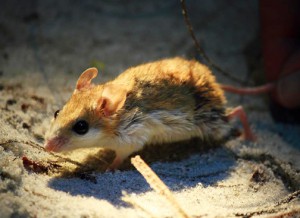
The Choctawhatchee Beach Mouse is one of four Florida Panhandle Species classified as endangered or threatened. Beach mice provide important ecological roles promoting the health of our coastal dunes and beaches. Photo provided by Jeff Tabbert
Beach Mouse
Beach mice are like the Loch Ness monster – everyone talks about them, but no one has seen one. Many locals have lived on this beach all of their lives and have never seen one – but they are there – and they are protected. The deal with protection is that these are isolated populations on each island. With no chance to mix genes, they have become “unique” and found no where else. There are four species in the state listed as endangered – including the nearby Perdido Key Beach Mouse and the Choctawhatchee Beach Mouse. It is believed the subspecies found on Pensacola Beach is the Santa Rosa Beach Mouse and is not listed as endangered – but is a species of concern (see list in link below). These little guys dig multiple burrows throughout the dune field but prefer those that are more open and have plenty of sea oats. They emerge at night feeding on a variety of seeds, fruits, and even insects – but sea oats are their favorite. It has been suggested they play an important role of dispersing these seeds. The introduction of new predators, and human development, have put these guys at high risk of extinction.
As you can imagine, the tracks are tiny. They are round in shape and show claw marks.
Read more:
https://edis.ifas.ufl.edu/pdffiles/UW/UW17300.pdf.
https://myfwc.com/media/1945/threatend-endangered-species.pdf.
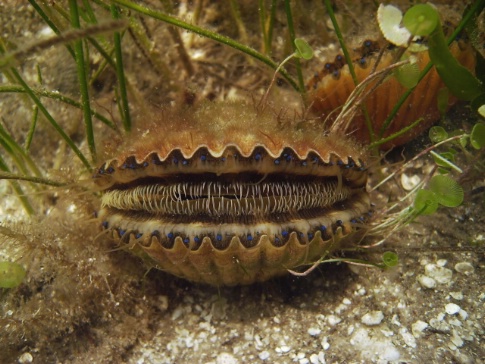
by Rick O'Connor | Aug 14, 2020
For some of us this is an annual gathering no different that Thanksgiving or Christmas. The family all knows the gig – “Kids get your things together – we’re heading to St. Joe!”
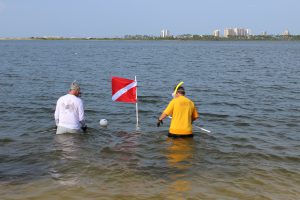
Scallopers heading out for a day of fun.
Photo: Molly O’Connor
For others, it is something we do when we can – the stars all align with work and we decide “Hey, Let’s go scalloping!”
For some, it is a new thing we want to get involved in. It is a fun family activity. Loading up the car with your snorkel gear, maybe choose camping instead of a hotel, maybe just go over for the day – (note: I do not recommend this option – I have done this and it is a LONG day – you will enjoy it more if you stick around and cook your scallops over there).
For those who have NO idea what we are talking about – we are talking about that great Florida family activity of SCALLOPING.
So, what is scalloping you say?
I guess you know by now that it is fun – and it is. Scallops are small bivalves that live in the seagrass beds. You just have to have a mask and snorkel to go find them – and you don’t have to go very deep. They lay right on top of the grass, their little blue eyes staring at you, and you pick them up. OH! they can swim! – not very well, but they can swim! The fun part is that it is a great day on the water, you get to see all sorts of other cool marine life while hunting, everyone is playing and splashing, and the day ends with a really seafood meal – maybe around a campfire. Good times for sure.
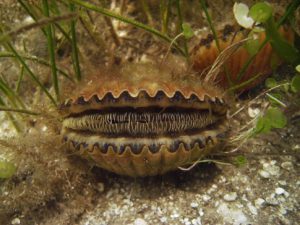
Bay Scallop Argopecten irradians
http://myfwc.com/fishing/saltwater/recreational/bay-scallops/
You may ask – “why do I have to go all the way to Port St. Joe to do this?”
And that would be a good question.
The bay scallop was once found along the entire Gulf coast, and even on part of the east coast, of Florida. There was a commercial fishery for the guy. But, overharvesting, poor water quality, and habitat loss, caused a decline. First, the commercial harvest was stopped. Then areas of the coast, including the Pensacola Bay area, were closed to recreational harvesting. Today there are a few regions in the Big Bend area where you can still scallop. Each region has its own “season” and the closest to us is Port St. Joe in Gulf County. This region extends from Mexico Beach to St. Vincent Island. It opens August 16 and closes September 24.
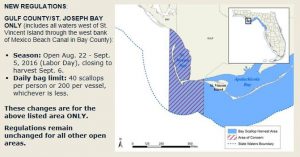
http://myfwc.com/fishing/saltwater/recreational/bay-scallops/
Because it is a managed recreational fishery now – there are some rules.
– Each person is allowed 2 gallons of whole scallop, or 1 pint cleaned.
– Each boat (if you take a boat) is allowed 10 gallons whole, or ½ gallon cleaned.
– Snorkelers are to have a dive flag and be within 100 feet of it at all times.
– A fishing license is required to harvest unless (a) you are exempt from having to have one (see FWC’s website on who is exempt), (b) you are wading – your feet never leave the bottom.
To clean them you only need a knife or flathead screwdriver to pry open the shell. The adductor that opens and closes the shell is the part you eat. Remove the viscera from around it, keep it cold, and cook when you are done. Fried, broiled in butter, there are numerous ways to do this.
It really is a lot of fun, and they are really good to eat.
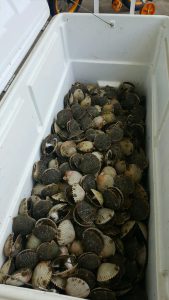
Prepared properly: One of the finest meals you will ever have.
The “everything you need to know scalloping” FWC page can be found at – https://myfwc.com/fishing/saltwater/recreational/bay-scallops/.
GO HAVE FUN!
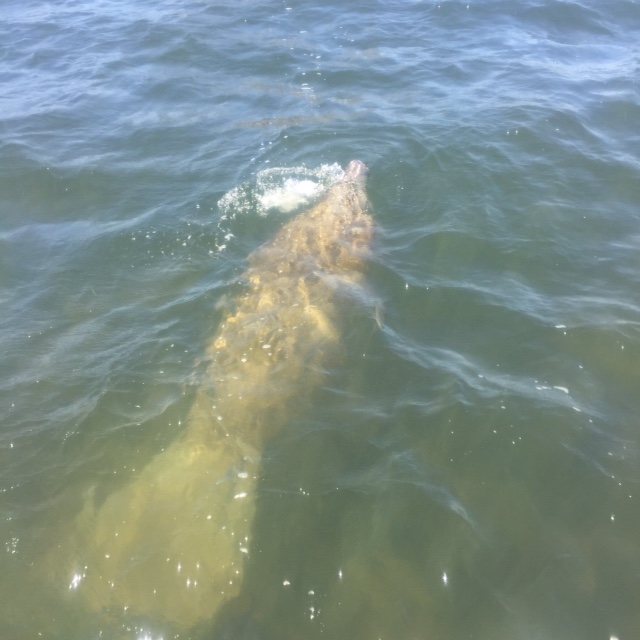
by Rick O'Connor | Aug 13, 2020
Mammals are historically land-based, or terrestrial, animals. They are quadrupeds (four legs) and run with a cursorial form of locomotion (backbone moving up and down) – some are the fastest land animals the planet has ever seen. But as fate would have it, some returned to the sea and occupied niches there. They are so well designed for a life in water that even look like fish. However, they differ in several ways:
1) Their tail extends horizontally instead of vertically and moves in an up and down motion instead of a side to side.
2) They of course lack scales, but they lack the characteristic hair of mammals as well. Though some hair may be found if you look close enough, they use blubber (layers of fat) to keep their bodies warm instead. Due to their warm blooded-ness, many do very well in cold parts of the ocean.
3) They also have mammalian lungs – not gills. Amazingly they exchange almost 90% of the air in their lungs with each breath (compared to about 20% for humans). With this huge load of oxygen, they remain underwater for long periods of time and dive to deep depths. The record would belong to the sperm whale who can dive to depths of 3000 feet for up to 90 minutes!
4) And of course, they give live birth nurturing the developing fetus with a placenta and feeding the developing young with milk from their mammary glands – this is not found in fish.
There are three orders of marine mammals: The Cetaceans (whales and dolphins), Pinnipeds (seals and sea lions), and Sirenians (manatees and dugongs). All three were once found in the Gulf of Mexico. Today there are only cetaceans and sirens, the lone pinniped (the Caribbean Monk Seal) is now believed to be extinct.
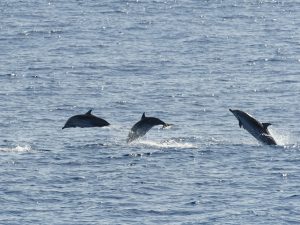
A group of small dolphin leap from the ocean.
Photo: NOAA
Dolphins
The Atlantic Bottlenose Dolphin (Tursiops truncatus) is the most common dolphin seen by visitors in our area. This lively, playful, and intelligent creature is the one most often seen at aquarium shows. Dolphins are whales, just small ones, and belong to a group known as “toothed whales”. They have numerous conical canine-type teeth used for grabbing fish and squid. Lacking molars, they cannot chew – so they must select prey they can either cut into smaller pieces, or swallow whole as is.
The toothed whales are known for their ability to detect prey using a form of SONAR called echolocation. Sound pulses are produced by flaps of skin within the blowhole (the nostrils of the dolphin) and exit the animal through a blob of fat in the head called the melon. Low frequency clicks can travel farther and find the targets, high frequency clicks have smaller range but can tell the dolphin what type of fish it is, and some whales can even produce high enough frequencies to literally “stun” their prey in the water – making it easier to grab. These “echo’s” or “clicks” are usually above (or below) our hearing range.
Dolphins are very social animals, traveling in large groups called pods. The pods are typically made of adult females and young, though there are one or two males. They communicate with each other using sound. The sounds are produced from the larynx in the blowhole area and are distinct for each pod. Outside dolphins are usually not allowed within the pod, so dolphins are not always the friendly creatures we perceive them to be – at least to each other.
When mom gives birth to a single calf (though very rare, twins have occurred) she rolls while swimming forward to expel the young – who must quickly surface for it’s first breath. The other females in the pod usually help with this. The baby suckles milk from hidden mammary glands which the mom exposes with the calf nudges her side. The calves stay with their moms for about two years learning the tricks of the trade before the cycle begins again.
These are truly amazing animals. Read more about dolphins at:
https://www.fisheries.noaa.gov/species/common-bottlenose-dolphin.
https://www.dolphincommunicationproject.org/index.php/the-latest-buzz/the-dolphin-pod/item/94419-how-does-echolocation-work.
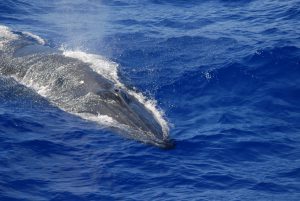
The large head and double blowhole of a Bryde’s whale.
Photo: NOAA
Whales
Though dolphins are whales, there are many others. The order Cetacea is broken into two suborders – the toothed whales (Odontoceti – which includes the dolphins) and the baleen whales (Mysteiceti). There are at least 20 species of whales and dolphins reported from the Gulf of Mexico – only one of those is a baleen whale, the Bryde’s Whale. Mammals as a group are known as heterodonts (meaning they have more than one type of tooth in their mouths). You, for example, have incisors, canines, pre-molars, and molars. Whales and dolphins break this rule by being homodonts. The toothed-whales and dolphins have conical canine teeth. Baleen whales have a fibrous hair-like material in their upper jaw that is stiff like the bristles of a toothbrush called baleen. The whale swallows seawater and then pushes it through the baleen trapping small shrimp and fish which they lick down their throats.
Whales are known for their long migrations – some of the longest in the animal kingdom. Their thick blubber and large size allow them to survive in polar waters – where much of their food is found. However, their babies are smaller (albeit 5-10 feet small) and they are not prepared for such cold waters. So, mom must migrate to tropical waters to give birth – fatten the baby up with some of the richest milk in the mammal group – and migrate back so she can feed herself. To navigate they use sound, the Earth’s magnetic field, and their eyes to do so. Whales can produce very low frequency sounds that can travel thousands of miles across the ocean echoing off objects that may be familiar to them. They also have magnetite in their retinas that allow them to pick up the Earth’s magnetic field, much the same as a compass does. And scientists also believe the act of spyhopping, where a whale will stop – turn vertical in the water – and extend their head above the surface – is in fact checking landmarks to aid them.
As with dolphins – these are amazing animals. Read more at:
https://aquatic.vetmed.ufl.edu/services/stranding-response/marine-animals-of-the-gulf-of-mexico/.
https://www.fisheries.noaa.gov/species/brydes-whale.
http://www.pbs.org/kqed/oceanadventures/episodes/whales/indepth-navigation.html.
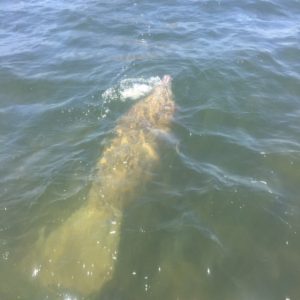
Manatee swimming in Big Lagoon near Pensacola.
Photo: Marsha Stanton
Manatees
“Mermaids”… at least that was what Christopher Columbus thought when he reached the new world. I guess they have that body shape… I guess. These are marine mammals but are not related to whales and dolphins. Instead, their closest living relatives are elephants. This is because mammals are divided into orders based on the type, and number, of teeth they have – and manatee teeth are nothing like dolphins. They have square shaped molars with ridges on the upper surface for grinding plant material – they are vegetarians. Most herbivores, like horses, have large incisors that can cut the grass and then move them back to their gnawing molars. Manatees lack these incisors. Instead they use their large lips, much the same as an elephant uses its trunk, to extend – and grab the grass, pulling it from the bottom of the bay and then gnawing with those big molars.
The differ from dolphins in other ways:
1) Their fluke (tail) is more round than forked – and they travel MUCH slower.
2) They lack a blow hole – but do still have nostrils. They are positioned closer to where ours are so they must extend part of their head out of the water in order to breath.
3) Though some whales lack dorsal fins – all manatees do.
4) They also do not tolerate polar waters very well. There was one species – the Stellar Sea Cow – that lived in Alaska, but this animal was MUCH larger than the tropical manatee – large size allows you to maintain a higher body temperature. It is now extinct – hunted out by fishermen as a food source while fishing. The animal was actually named after one of them – Captain Georg Stellar.
5) They are also not as social – manatees are usually loners except during breeding season and gathering in warm springs during the winter.
That said, they are migrators as well. They will venture out during the warm months to seagrass beds in the north – including Pensacola Beach – returning to the warm springs of central Florida, or the tropical waters of south Florida, in the winter. Navigation, in their case, is a bit easier – they are coastal – manatees do not travel out to sea as whales and dolphins do. They slide along the coastline, eating as they go, enjoying the sun, and avoiding boats. Locally we see them along the Gulf side, in the Intracoastal, and even up into the bays and bayous of Pensacola Bay as they move from Mobile Bay to and from central Florida.
WE DO HAVE A CITIZEN SCIENCE REPORTING PROGRAM FOR THIS ANIMAL.
If you see one contact Sea Grant Agent Rick O’Connor (roc1@ufl.edu ). We would like to know – exactly where you saw it, date you saw it, time you saw it, was it alone, and which direction was it traveling.
As with other marine mammals – manatees are amazing to see and can be the highlight of your visit. We ask that while boating, when you approach shore please slow speed and (if possible) have a spotter looking to make sure you do not hit one of these charismatic creatures.
Read more at:
https://www.fws.gov/refuge/Crystal_River/wildlife_and_habitat/Florida_Manatee.html.
https://www.savethemanatee.org/manatees/migration/.
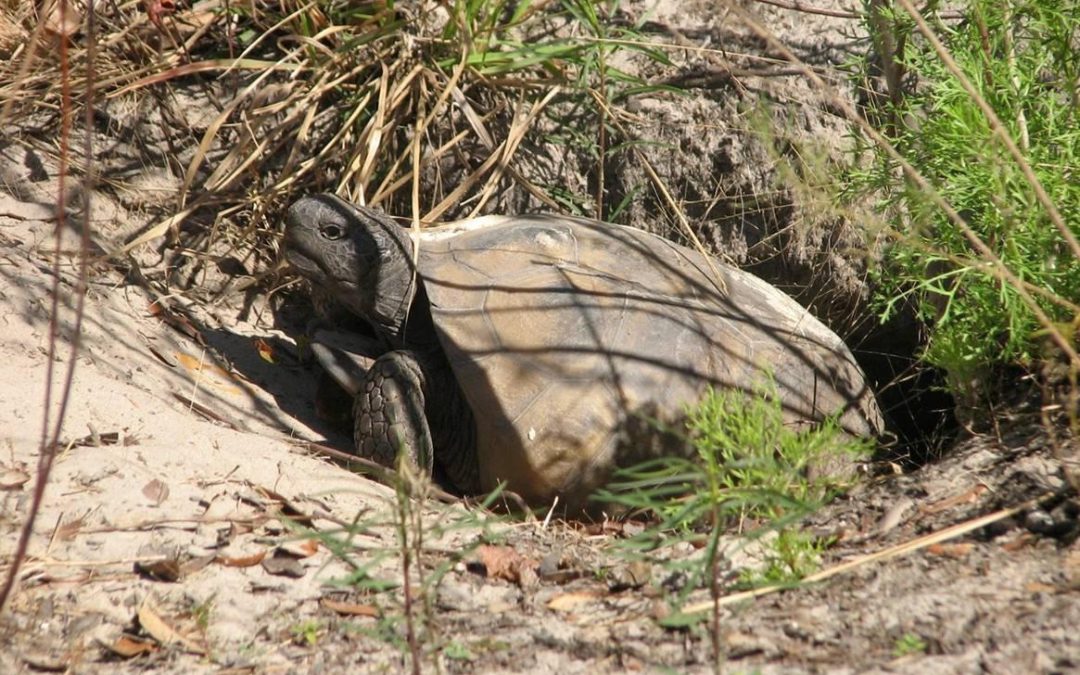
by Rick O'Connor | Jul 16, 2020
This blog will wrap up our series on Florida turtles for the Year of the Turtle (2020) – and we end with a good one – the gopher tortoise. We only have two true terrestrial species of turtles in Florida, and it does not get more terrestrial than the gopher tortoise.
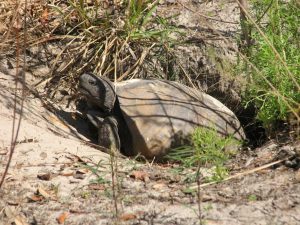
Gopher tortoises are long-lived, protected by their thick shells and deep burrows. Photo credit: Carrie Stevenson, UF IFAS Extension
“Gophers” (Gopherus polyphemus) are well known to many ole timers because they like the same type of habitat the earlier settlers did – high dry ground. They are indigenous to the southeast United States and prefer the open canopy of pine forest habitat. As a kid our home was on such a place in an area of Pensacola called Scenic Heights. Our house was on a “sand hill” that had pine and turkey oak trees. There were a variety of grasses and legumes growing everywhere and the soil was very dry and sandy. And we had gopher tortoise. The famous 18th century traveler/botanist, William Bartram, described this animal several times during his travels across the southeast as he crossed “sand hills” within the massive expanse of pine forest that were here at that time.
Though a forest, the longleaf pine forest of the southeast had a more open canopy allowing the growth of a variety of grasses to do well on the forest floor – as they did at my house. Tortoises are vegetarians, eating a variety of these grasses, flowers, and ground fruit. They like the young tender shoots of these plants and they were maintained those decades ago by natural wildfires started by lighting. The small fires would burn the large, tough plants down, providing the young tender shoots the tortoises prefer.
If you see a tortoise, you will notice the large square shaped shell and the elephant-like feet – definitely not a water turtle. They dig burrows in this sandy soil in which they can live during the hot days of summer and the cold days of winter. These burrows can be quite extensive – reaching a length of over 15 feet and a depth of up to 7 feet from the surface. Though the literature will tell you that they prefer dry sandy soils for digging, they have been found digging in the red clay of the southeast as well. However, these burrows are generally not as deep because the O2 levels decline and the CO2 concentrations increase significantly in clay soils. There is only one entrance to the burrow, and it has been said that gophers can dig down – but not up.

Gopher tortoises are nesting right now–be sure to observe from a distance!
It is generally one tortoise to a burrow, but some will dig a second burrow within their range as a “back-up” during pop up thunderstorms and such. It is not uncommon to find 2-3 tortoises sharing he entrance of a burrow during stressful moments – or during mating of course. The temperatures within are nice a cool during the summer – ranging from 60 – 72°F. This “air conditioned” hide away has become popular with many other creatures of the pine forest. Over 350 species of them have been known to share the burrow. Most of these are insects but a few vertebrates are known to call including – the gopher frog, mice, the endangered eastern indigo snake, and the eastern diamondback rattlesnake. Most of these animals use the burrow during extreme conditions – heavy rain, intense heat or cold, or during a forest fire. The rattlesnakes tend to sit near the entrance and so observers should beware of sticking their face or hand into the opening looking for a turtle. Many field workers will use a small hand mirror to look into the opening. Either you see the rattlesnake, or, the reflection of sunlight into the burrow will cause the snake to rattle – altering you they are there.
Terrestrial turtles produce fewer young than aquatic species. Gophers will typically produce 5-9 eggs once a year. The eggs are usually buried within the “apron” of the burrow – this is the field of sand discarded while digging. There is a projection from the anterior end of the plastron called a gular. This projection is much longer in males and can be used in jousting matches with other males. Males will also have a concave depression from the midpoint to the posterior end of the plastron. Though mating can occur any time of year – most activity is from May to July.
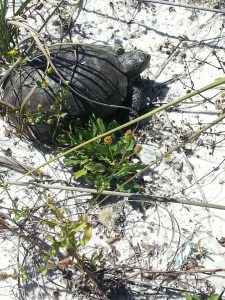
A terrestrial gopher tortoise crossing the sand on Pensacola Beach.
Photo: DJ Zemenick
These animals have declined across their range. They have the typical turtle egg raiders (raccoons, fox, skunks, and opossums) but now have threats from invasive species such as tegus and fire ants. Hatchlings and juveniles have soft shells and are easy targets. Coyotes have been seen hiding behind burrows flipping the emerging tortoise and then consuming it. However, man has been a problem as well.
Food was one problem, and apparently still is in some parts of the south. These animals were “noosed” from their burrows and cooked. During the depression era they were known as “Hoover’s Chicken”. As mentioned at the beginning – they live where we want to live. Construction crews come in and cover “entomb” them during development projects. It is now against Florida law and crews must relocate them.
In natural areas, the suppression of natural wildfires as altered the ecology enough that food for the gophers has become an issue. As they abandon their burrows seeking better spots, they are preyed upon, run over by cars, attacked by dogs, the list goes on. In recent years, an upper respiratory tract disease has proven to be common and deadly.
Today the animal is federally protected in Louisiana, Mississippi, and western Alabama. It is species of concern throughout its range and is a state threatened species in Florida. You cannot possess this animal but having one move into your yard is fine.
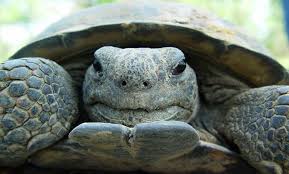
This gopher tortoise was found in a dune field; a place where they have historically been found.
Photo: DJ Zemenick
I hope you enjoyed this series on Florida turtles, during the YEAR OF THE TURTLE. You can find more blogs on other species by visiting the natural resource page of the Escambia County Extension website and type in which species you are looking for in the “what can we help you with?” search tool at the top of the page. https://sfyl.ifas.ufl.edu/escambia/?topic=natural-resources#county-feed.
I hope you are lucky enough to find all 25 species in the wild.
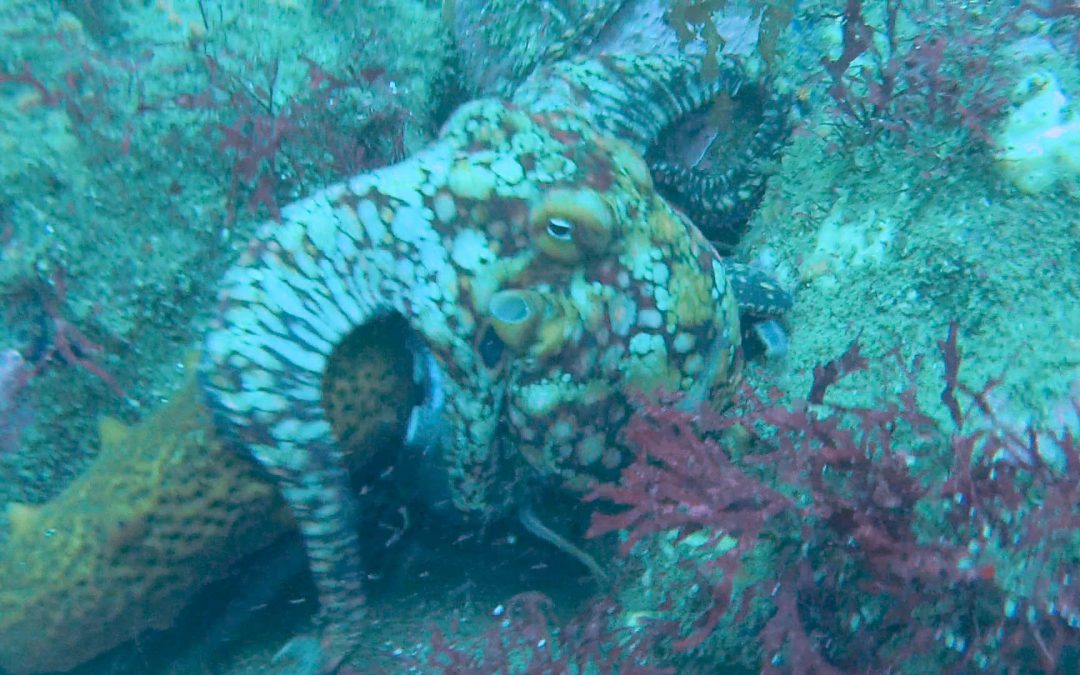
by Rick O'Connor | Jul 7, 2020
For many of the blogs we have posted on marine life of the Gulf of Mexico I have used the term “amazing” – but these cephalopods are truly amazing. There have been numerous nature programs featuring not just marine invertebrates but rather highlighting the cephalopods specifically. We have been amazed by their looks, their colors, their intelligence, and their ferocity. They are the animals of ancient mariner legends – the “kraken”.
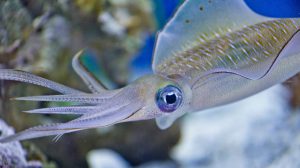
These are not your typical mollusk. The elongated body and lack of external shell changes everything for cephalopods.
Photo: California Sea Grant
But for us who just visit the beach to play and walk – we rarely see them. They are quite common. The squid are almost transparent in the water column as they swim and usually run deep until nighttime. The only ones I have ever encountered were hauled up in shrimp trawls – but they are usually hauled up each time, and sometimes in great numbers. Octopus are more nighttime roamers as well. I have occasionally seen them diving during daylight hours, but they are very secretive and well camouflaged. I have found cephalopods both in the Gulf and within the estuaries – again, they are more common than we think.
A study conducted in the 1950s logged 42 species within the Gulf of Mexico. Many of them live in the open sea and at depths of 350-500 feet. There are actually four types of cephalopods – the octopus and squid we know, the cuttlefish and nautilus less so because they are not common in the Gulf region.
They are mollusk but differ from their snail and clam cousins in that they have very little, if any shell. The nautilus is an ancient member of this group and still possess an external shell. However, it is chambered and can be filled with gas like a hot air balloon allowing the nautilus to hover off the seafloor – something their snail/clam cousins can only dream about.
The squid and cuttlefish have reduced their shell to a surfboard looking structure that is found internally, serving almost like backbone. It allows them some rigidity in the water column, and they can grow to greater size. Actually, the squid are the largest invertebrates on the planet, with the “giant squid” (Architeuthus) reaching lengths of 50 feet or more.
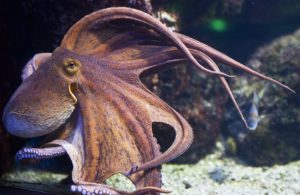
The octopus differs from the squid in that it lacks a shell all together. Thus, it is smaller and lives on the ocean floor.
Photo: University of South Florida
The octopus lack a shell all together. Without this rigid bone within, they cannot reach the great size of the giant squid – so giant octopus are legend. However, there is a large one that grows in the Pacific that has reached lengths of 30 feet and over 500 pounds – big enough!
The lack of a shell means they must defend themselves in other ways. One is speed. With no heavy shell holding you down, high speed can be achieved. Again, squid are some of the fastest invertebrates in the ocean – being clocked at 16 mph. This may not outrun some of the faster fish and marine mammals, and many fall victim to them. Birds are known to dive down and eat large numbers of them. But they can counter this by having chromatophores. These are cells within the skin filled with colored pigments that they can control using muscles. This allows them to change color and hide. And their ability to change color is unmatched in the animal kingdom. I recommend you find some video online of the color change (particularly of the cuttlefish) and you will be amazed. Yes… amazed.
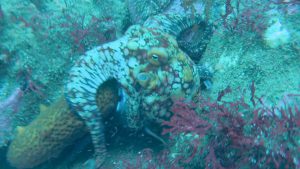
The chromatophores allow the cephalopods to change colors and patterns to blend in.
Photo: California Sea Grant
To control such color, they must have a more developed brain than their snail/clam cousins – and they do. The large brain encircles their esophagus and not only be used to ascertain the colors of the environment (and how to blend in) but also has the capability of learning and memory. The octopus in particular has been able to solves some basic problems – to escape, or get food from a closed jar, for example. Many of these chromatophores possess iridocytes – cells that act has mirrors and enhance the colors – again, amazing to watch.
All cephalopods are carnivorous and hunt their prey using their well-developed vision. Squid prefer fish and pelagic shrimp. Octopus are inclined to grab crustaceans and other mollusk – though they will grab a fish when the opportunity presents itself. Cephalopods hunt with their tentacles – which are at the “head end” of the body. The squid possess eight smaller arms and two longer tentacles. Each have a series of sucker cups and hooks to grab the prey. They keep their tentacles close to their bodies and, when within range, quickly extend them grabbing the fish and bringing back to the mouth where a sharp parrot-like beak is found. They bite chunks of flesh off and some have seen them bite the head off a mackerel. I was bitten on the hand by a squid once – one of the more painful bites I have ever had.
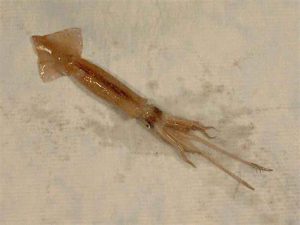
The extended tentacles of this squid can be seen in this image.
Photo: NOAA
The octopus does not have the two long tentacles – rather only the eight arms (hence its name). They move with stealth and camouflage (thanks to the chromatophores) sneaking up on their prey – or lying in wait for it to come close. Here things change a bit. Octopus possess a neurotoxin similar to the one found in puffer fish. They can bite the crab – inject the venom – which includes digestive enzymes similar to rattlesnakes and spiders – and ingest the body of the semi-digested prey after it dies. They can drill holes into mollusk shells and inject the venom within. Most will give a painful bite but there is one in the Indo-Pacific (the blue-ringed octopus) whose venom is potent enough to kill humans.
Making new octopus and squids involves the production of eggs. The male will deposit a sac of sperm called a spermatophore into the body of the female. She will then fertilize her eggs and excrete them in finger like projections that do not have hard shells. Squid usually die afterwards. Octopus will remain with the eggs – oxygenating and protecting them until they hatch. At which time they will die.

Though we have a variety of cephalopods near shore – the real grandeur is offshore. Out there are numerous species of bioluminescent cephalopods – most living at 500 feet during the day and coming within 300 feet at night. Many swim, while some float, others have developed a type of buoyant case they can carry their eggs in. Far too much to go into in a blog such as this one. I recommend you do a little searching and learn more about these amazing animals.
Enjoy the Gulf!

























